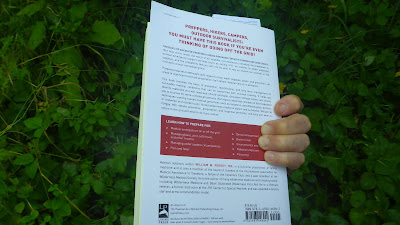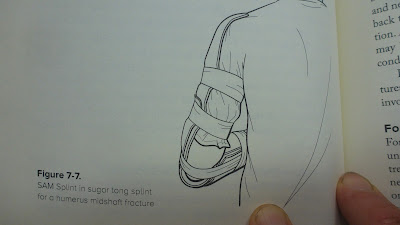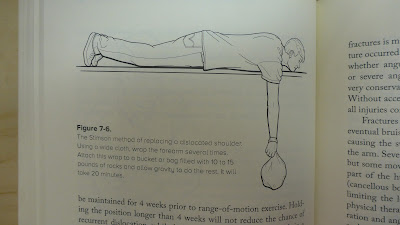By BCT
The Prepper's Medical Handbook
Author: William W. Forgey, MD
Available as a Kindle version (e book- ISBN 978-1-4930-4695-9) or softcover paperback
Lyons Press
An Imprint of The Rowman & Littlefield Publishing Group.Inc.
ISBN 978-1-4930-4694-2 (Paperback edition).
2020
The Prepper's Medical Handbook
Author: William W. Forgey, MD
This is an excellent text and maybe that comes as no surprise as Dr Forgey (pronounced FORGEE) is a well known name in the field of wilderness medicine. His writings are backed up by real field experience in providing medical care for numerous years in remote areas of Haiti. Drawing on his experiences of almost 3 years as a young infantry soldier in Vietnam, Dr Forgey delivers straight to the point pertinent medical information for factual preparedness for "off the grid" situations.
Just quickly if you don't know what defines "off the grid" , well this means basically no access to everything powered the energy sources we take for granted in our daily lives.
If ever there was a text which should be mandatory for preppers to read is this book and not just preppers but anyone who just wants to be responsibly prepared for a worst case scenario.
The contents section is well laid out in a logical order. We start with the definitions of "Off the Grid Vs No grid" medical prepping.
The book comprises of 11 chapters covering the following subjects:
1/ How to prepare for Medical care off the grid
2/ Assessment and stabilization
Section Cardiac Evaluation and care
In this straight to the point chapter (actually it's all pretty much straight to the point information within this book), Dr Forgey tells it how it is if there is no pulse and the reasons why CPR would be conducted in the absence of a defibrillator.
3/ Body system symptoms and management
4/ Radiation Covers shielding and treatment of radioactive poisoning, plus debunks certain myths regarding shelf life of KI as a medication. (see further below).
5/ Dental care
The take home message is right on the first page of this chapter: Exercise preventative dental care is vital if one is to remain off the grid for any length of time.
He recommends the age old substitute for toothpaste, baking soda or salt. And of course regular flossing. In my opinion, including dental floss into ones bag for camping trips, either short or extended is better in some cases and certainly lighter than carting toothpaste along. The floss can be used for a myriad of other things too.
The take home messages in this chapter is to not get any dental problems, simply because serious dental problems are going to need serious attention from the grid!
Even a gum infection gone bad into surrounding tissue. Heck it makes my skin crawl just thinking about this and how we are so really "soft" and take dental care for granted.
6/ Soft tissue and trauma
As stated the biggest cause of hospital admissions in the USA are wounds of some sort. This is a absolute must to know how to treat wounds and the first one Dr Forgey starts out with is "Bleeding". Speaking from a personal aspect, I'd have to say, if one doesn't know how to treat bleeding wounds, then better not go into the outdoors. I was once filming a piece which required me to be sitting up to my neck in water for several days on end. It was really hot like 38C, like 100F!, so being in the water was quite refreshing every day but then came the day where I had left it too late to get down to the river by foot, so i decided to take a bike. I had the previous day put a make shift towing mechanism onto the bike which was out of necessity rather rough and ready and quite dangerous as it was made out of rough off cuts of galvanized rectangular electrical conduits. Ok I won't go into why this contraption was on the bike but it was and it should have been taken off before I set off to the river carrying an overly heavy rucksac full of camera gear. In fact i should have just taken a cold drink and waiting until morning of the next day to film. No I had to go. Well i swung my leg over that bike and connected directly with those sharp dirty pieces of metal protruding like some ploughing instrument of death off the back of that bike and cut my leg open to all that lovely "white stuff" including a good sized artery, like the ATA!. Quick thinking as that garden hose of blood gushed forth like some crazy Japanese horror movie and the even quicker actions of a well- taught 4 year old son who I had to call out to (as i never left the property I was now sitting with leg clamped and raised up against the barn wall). He came dutifully to his dad and obviously was phazed by all of the blood soaked clothing on me and I said, "Hey mate go into the bedroom and get that bottle of Iodine on the floor for daddy, can you?" We had discussed what that "brown stuff" was used for the day before LOL! He left and returned very quickly (about 20 metres away) with that bottle of iodine and removed my shirt which I was pressing into the wound, quick doused the entire area with the solution (I didn't hurt, i had too much adrenalin flowing in my veins by then)- the rest is history after hospital and 10 stitches later! My point is, yeah don't freak out at blood and know what to do. I did in fact require hospitalisation and a road trip of 80km to the closest hospital A snd E. Now if there wasn't a hospital, I would have been a bit in trouble as no antibiotics, no tetanus booster (they gave me one in the hospital and antibiotics) and no sutures let alone a needle and forceps to stitch myself up! So don't skip this chapter if you've never dealt with a lot of blood before (and that wasn't a lot of blood according to the missus (she's an ICU specialist and anaesthetist!)
7/ Orthopaedics
Broken bones, dislocations, dispelling myths, the Stimson method for replacing a dislocated shoulder. etc., all great stuff!
8/ Bites and Stings ( A big favourite of mine being an Aussie! Plus see below)
Ah yes, ticks are included here and they are also a favorite of mine. I've just been the victim of numerous (as in 20 tick bites-luckily not species capable of transmitting (ie vectors) tick borne diseases. However, I was once danged by a paralysis tick of quite large proportions. Whilst on our way home one evening after a week of camping, I was driving and felt a strong itching on the back of my neck. I reached up and found a cm sized moveable lump there! Everyone else in the car was asleep of course and I should have stopped but I just foolishly grabbed this lump and extricated it from my neck. Big mistake because when one does this there is a good chance you will only cause the tick to envenomate you further whilst trying to pull it out. The result was a golfball sized lump on the back of my neck by the next morning and lots of bruising too because I was squeezing this area as half of neck was completely paralyzed! two days later when got to the city and doctor and course of antibiotics. Arrrggghh! Ticks I hate them. I was so stupid because I had ticks on me countless time and all of those times i removed them either with tweezers by grabbing them right next to the skin. Even Forgey suggests taking a little bit of skin with the tick LOL and say this doesn't hurt. Of course it doesn't hurt if it is a paralysis tick because you are sort of already anaesthetised in that area already from the tick (if it's of that type).
But DEET as Dr Forgey suggests is definitely the best defence against ticks and just about any biting insect (in Australia for sure). Just as an extra (not in his book), I'd add Citronella oil is extremely effective against sand flies too!
9/ Bio terrorism and Infectious Diseases
10/ Environmental injuries eg covers such things as "Altitude sickness" Otherwise known as AMS Acute Mountain sickness, Pulmonary Edemas related High Altitude.
This is also a favourite chapter of mine as I've had experience at high altitude and seen several who needed to be evacuated to lower altitudes immediately. The results were remarkable and Dr Forgey is quick to point this out in the introductory section for High Altitude Illnesses pg 265.
11/ Off the Grid Medical Kit
This final chapter deals with all the stuff you need to know about in order to put a relevant kit together.In other words dealing with both restricted and no restricted medications and bandaging etc.
The subject matter within the Preppers Medical Handbook is laid out in a logical easy to read order and in my opinion is suitable for both the professional and the layman.
The illustrations are done by Robert L. Prince who is an accomplished illustrator of instructional information.
Despite being in black and white they are more than detailed enough to be able to follow. However, I would always recommend that one does a registered/certificate course in regards to administering any physical procedures such as first aid and other actions as detailed within this text (in fact Dr Forgey says the same within this text). This text will help to not only consolidate material learnt in such courses but also add significantly to one's knowledge.
Forget those martial arts movies where someone puts their own shoulders back into place, I like the Stimson method shown above!
The book is easy to read and it is clear it has been written by medical doctor, however, jargon has been kept to a minimum.
The text isn't dry or boring and sometimes an addition of light humour can be found in what otherwise could be thought of as a doom and gloom situation.
It covers "survivable medical conditions" where one needs to solely rely upon ones own resources and training.
This book concerns the "off the grid" situations and the zero grid situations
What's the difference?
Off the grid just means for whatever reason you can not access stuff like hospitals and emergency services such as the police and fire brigade.
Zero grid, means it's all gone, the worst case scenario and as Dr Forgey says:
TEOTWAWKI
The Preppers's Medical Handbook is about managing many medical situations without outside assistance, in other words without access to the grid. The text also tells you when it is imperative to get help from the grid, for example immediate evacuation situations such as Heart attacks, fractures of teeth below the gum line and ectopic pregnancies.
You may be saying at this point, WHOA! That's not going to happen to me and my friends, well I'm afraid if you are thinking like this then you had better change your mind about becoming a Prepper or even well prepared for survival. Prepping unfortunately brings to mind, lots of guns, ammo and secreted away underground shelters. Not true. No amount of guns and ammo is going to help you if you can not deal with a simple medical situation, which may or may not require urgent assistance from some trained doctor or paramedic
It's no good if your fall out shelter is full of food for 20 years and guns and ammo for another 40 years, if your head is not full of quality knowledge of what to do if a medical emergency arises. A simple medical situation such as a tooth half hanging out of your mouth could pose a life threatening situation if not promptly attended to as I've just noted and what is dealt with thoroughly within these pages.
What to do if you are "off the grid" (OTG)?
Serious preppers have serious information in their heads, not just stuff about knives guns and ammo or secret locations.
That is exactly that, when either the grid has failed or one can not get back to the grid for whatever reason or the grid no longer exists in the worst case scenario.
The Prepper's Medical Handbook should be read in conjunction with a certified course in Basic First Aid and or Advanced First Aid or a course in Pre Hospital Trauma Life Support courses (PHTLS).
Succinct and fairly straight to the point reference text, assuming previous knowledge and or advanced clinical skills..
The radiation chapter I thought waffled on a bit (but this was from the perspective of a scientist evaluating it). My thoughts would have been somewhat different
eg get a proper dosimeter, understand how it works and know how to read it properly.
know the safe levels, what is not a safe level. In other words anything higher than background levels.
Read and understand how to treat cases of radiation poisoning.
Understand how food and water can become contaminated by radioactive materials and what shelters can provide the best shielding under the circumstances you find yourself in.
DEBUNKING SURVIVAL MYTHS
Dr Forgey also debunks many Prepper myths and or social media survivalist myths,
For example: myths such as tying hair to close scalp wounds.
Some chapters of special interest to me are the following;
Chapter 8 Bites and Stings
Being an Australian, we are all too familiar when it comes to the subject of bites and stings. Let's face it we do have quite a few nasties lurking both above and below the water.
I was quite interested to read what the Doctor had to say in this section.
I've had a long term association with snakes since childhood (keeping them as pets), later as a young adult catching venomous species such as Brown snakes, I was at some point a member of the Australian Herpetological Society (AHS) as well
and later also kept many snakes. Let's face it my parents property abounds with poisonous snakes such as Brown snakes (Pseduonadja textilis), we even had one for a time living in the pool filter room!
It's not surprising his advice for snake bite follows the standard procedure used Australia wide.
Don't bother looking for the section on sharks, they don't come into it and my experience as a scuba diver tells me why: There are far more dangerous sea creatures with which one can encounter with a much higher frequency than sharks and or an injury from them (most are fatal anyway).
For example, the first thing one learns in good quality SCUBA course when it comes to bites and stings, is that the humble stingray is a far greater danger. The same creature which was the demise of a particular TV personality who chose to ignore this common advice. Here too in the text we can find a section on the appropriate treatment for puncture wounds from a stingray's barb.
The book itself is laid out in a clear and logical way and should be read starting at the front, not randomly.
The illustrations are on the whole clear and easy to understand ( I did an advanced First Aid course - It's lapsed now and that means getting a refresher course but we worked too from illustrations in books and the old "Resussi Anne Doll"!).
The radiation diagram was IMHO too small and one almost needs a microscope to read it, however, the web link is given for more info????
Finally, towards the back of this well written 311 page book is a chapter dedicated to what entails an Off the Grid Medical Kit and thoroughly discusses restricted and non restricted medications and how one can put together such kits.
Verdict: must have reading material for all those who venture outdoors and as the name suggests Preppers (if you are serious).
BCT
About the Author












No comments:
Post a Comment